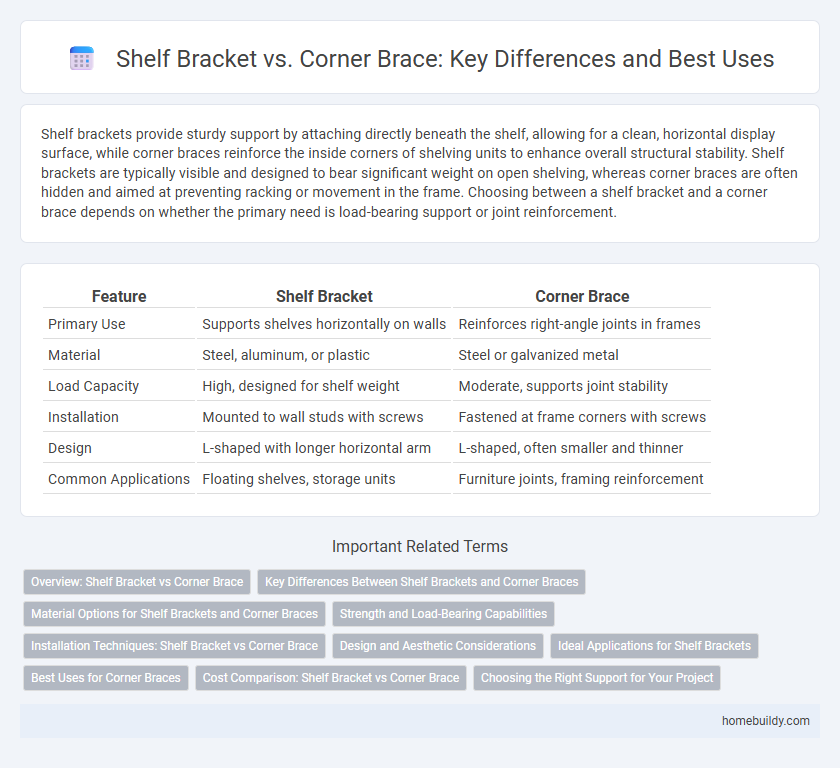Shelf brackets provide sturdy support by attaching directly beneath the shelf, allowing for a clean, horizontal display surface, while corner braces reinforce the inside corners of shelving units to enhance overall structural stability. Shelf brackets are typically visible and designed to bear significant weight on open shelving, whereas corner braces are often hidden and aimed at preventing racking or movement in the frame. Choosing between a shelf bracket and a corner brace depends on whether the primary need is load-bearing support or joint reinforcement.
Table of Comparison
| Feature | Shelf Bracket | Corner Brace |
|---|---|---|
| Primary Use | Supports shelves horizontally on walls | Reinforces right-angle joints in frames |
| Material | Steel, aluminum, or plastic | Steel or galvanized metal |
| Load Capacity | High, designed for shelf weight | Moderate, supports joint stability |
| Installation | Mounted to wall studs with screws | Fastened at frame corners with screws |
| Design | L-shaped with longer horizontal arm | L-shaped, often smaller and thinner |
| Common Applications | Floating shelves, storage units | Furniture joints, framing reinforcement |
Overview: Shelf Bracket vs Corner Brace
Shelf brackets provide horizontal support for shelving, distributing weight evenly along walls and offering aesthetic visibility in room design. Corner braces reinforce structural joints by stabilizing right-angle connections, commonly used in cabinetry or furniture assembly to prevent wobbling and enhance durability. Both components serve distinct purposes in construction and interior applications, with shelf brackets optimizing load-bearing capacity and corner braces ensuring joint stability.
Key Differences Between Shelf Brackets and Corner Braces
Shelf brackets are specifically designed to support horizontal surfaces like shelves, providing strong vertical and sometimes angled support, while corner braces are intended to reinforce right-angle joints in frames or furniture, enhancing structural stability. Shelf brackets often feature decorative designs and are visible when installed, whereas corner braces are usually metal plates installed inside joints, prioritizing strength over aesthetics. The load distribution of shelf brackets is optimized for holding substantial weight on a flat surface, whereas corner braces primarily prevent joint movement and increase rigidity.
Material Options for Shelf Brackets and Corner Braces
Shelf brackets and corner braces are commonly made from materials such as steel, stainless steel, aluminum, and plastic, each offering varying levels of strength and corrosion resistance. Steel shelf brackets provide high load-bearing capacity for heavy shelving, while aluminum and plastic options cater to lighter applications with added corrosion protection. Corner braces typically use similar materials but often prioritize sturdiness and rigidity to reinforce joints effectively in furniture and shelving units.
Strength and Load-Bearing Capabilities
Shelf brackets provide robust support with their L-shaped design, distributing weight evenly and accommodating heavy loads commonly up to 200 pounds or more, making them ideal for shelving applications. Corner braces, while effective for reinforcing joints at right angles, are generally less suited for heavy load-bearing and best used for structural stability rather than weight support. Choosing a shelf bracket over a corner brace enhances strength and load-bearing capabilities, ensuring reliable support for heavier items on shelves.
Installation Techniques: Shelf Bracket vs Corner Brace
Shelf brackets require mounting directly into wall studs using screws for optimal support, ensuring the shelf holds substantial weight without sagging. Corner braces typically install at right-angle joints, using smaller screws into the shelf and supporting surface to reinforce stability and prevent shifting. Shelf brackets allow for more adjustable and visible support, while corner braces provide discreet reinforcement primarily in cabinetry or furniture assembly.
Design and Aesthetic Considerations
Shelf brackets offer a streamlined design that seamlessly integrates with modern and minimalist interior styles, providing discreet support without compromising shelf visibility. Corner braces typically feature a more utilitarian and robust appearance, which suits industrial or rustic aesthetics but may appear bulky or intrusive in contemporary settings. Choosing between these hardware options depends on balancing structural needs with the desired visual impact in your space.
Ideal Applications for Shelf Brackets
Shelf brackets are designed to support horizontal surfaces such as shelves, making them ideal for displaying books, decorative items, or organizing storage in closets and garages. Unlike corner braces that reinforce structural joints at right angles, shelf brackets provide strong, visible support specifically for flat surfaces extending from walls. Their versatility and aesthetic appeal make them a preferred choice for residential and commercial shelving solutions where load-bearing and easy installation are critical.
Best Uses for Corner Braces
Corner braces excel in reinforcing right-angle joints, making them ideal for strengthening furniture corners, cabinets, and shelving units. Their L-shaped design provides superior support against lateral forces, ensuring stability in high-stress areas. Unlike shelf brackets, corner braces are best suited for structural reinforcement rather than just supporting horizontal loads.
Cost Comparison: Shelf Bracket vs Corner Brace
Shelf brackets generally offer a more cost-effective solution compared to corner braces, with average prices ranging from $5 to $15 per piece depending on material and size. Corner braces, often made of heavier gauge metal for structural support, typically cost between $10 and $25, reflecting their enhanced durability and load-bearing capacity. Choosing between the two depends on budget constraints and the required level of support for shelving projects.
Choosing the Right Support for Your Project
Shelf brackets provide sturdy horizontal support for wall-mounted shelves, ideal for holding weight and offering stability along the shelf's length. Corner braces are L-shaped metal fittings designed to reinforce right-angle joints, typically strengthening furniture corners and frames. Selecting the right support depends on the project's needs: use shelf brackets for load-bearing wall shelves and corner braces for enhancing the structural integrity of boxed or angled constructions.
Shelf bracket vs Corner brace Infographic

 homebuildy.com
homebuildy.com